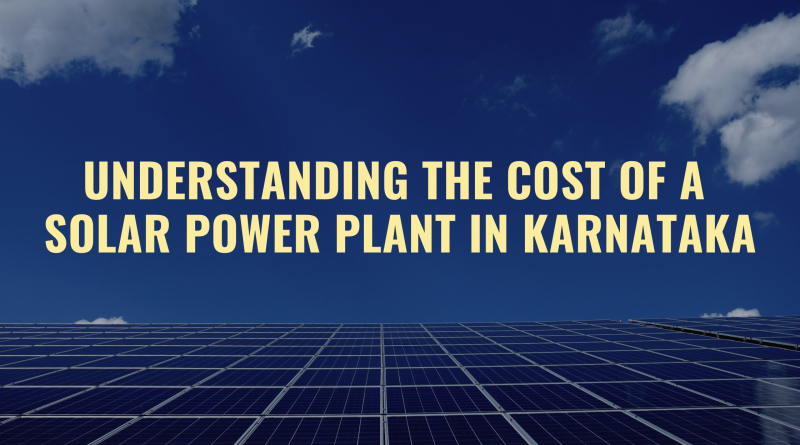What is the cost of setting up a solar power plant in Karnataka?
Using solar power is a ray of hope in the modern world, where sustainability is crucial. The establishment of a solar power plant in Karnataka has emerged as a feasible and indispensable undertaking for both individuals and enterprises, given the growing need for sustainable energy solutions.
How Much Does a Solar Power Plant Cost in Karnataka?
“What is the cost of setting up a solar power plant in Karnataka?” is the first question that comes to mind while discussing solar electricity. There isn’t a one-size-fits-all solution, though. The capacity, location, technology, and government regulations of a solar power plant are some of the elements that affect the overall investment needed to build one.

Capacity Matters: The initial basis for cost calculations is a solar power plant’s capacity, either in megawatts (MW) or kilowatts (kW). Undoubtedly, larger capacity requires more substantial investments. Nonetheless, they are a desirable option for business and industrial endeavors because of their potential for increased energy generation and long-term benefits.
Location: Karnataka has been provided with a variety of geographical features, such as sun-kissed plains and charming hill stations. Selecting the ideal site is essential for building up a solar power plant. An ideal environment for energy generation is one that receives plenty of sunlight all year round. Additionally, proximity to infrastructure resources affects logistics expenses.
Selecting Appropriate Technology: Many solutions for solar panels have emerged as a result of technological breakthroughs, and each has a different price range. Despite their greater initial cost, high-efficiency solar panels end up being more cost-effective over time because of their improved energy conversion rates.
Government Policies and Incentives: The government of Karnataka provides a number of policies, subsidies, and incentives available to encourage the use of solar energy. The setup expenses can be greatly decreased by being aware of and taking advantage of these perks.
Investment Calculation: A Detailed Method
A reasonable estimate for installing a solar power plant in Karnataka runs from INR 40,000 to INR 60,000 per kW for residential projects, while specific numbers can vary. Owing to their larger scale, commercial and industrial setups may experience more competitive rates, which will reduce the cost per kW.
With a typical home configuration of 5 kW, the approximate cost would be between INR 2,00,000 and INR 3,00,000. To obtain precise quotes that cater to your unique needs, it is imperative that you speak with solar specialists and suppliers.
Investing in a Sustainable Future: Solar Energy’s Transition
In conclusion, establishing a solar power plant in Karnataka necessitates thorough planning, thoughtful consideration of options, and long-term thinking. It is an investment in a sustainable, environmentally friendly future in addition to the monetary cost. Karnataka can set an encouraging example for the country by adopting solar energy and meeting its expanding energy demands while also leading the way in the adoption of renewable energy sources.
To fully realise the enormous potential of solar energy, people, companies, and the government must work together as Karnataka confidently moves towards a solar-powered future. Karnataka would be able to illuminate not only its cities but also the way forward for a more sustainable and greener future by doing this.
To promote solar power plants, the Karnataka government provides low-interest loans, tax breaks, and subsidies. These advantages are available to qualified business owners, greatly lowering the upfront outlay.
The capacity, location, and operating efficiency of the facility are some of the variables that affect the break-even period. Well-designed solar power plants may often reach break-even in five to seven years.
Through net metering arrangements, business owners can sell excess electricity back to the grid. This makes it possible to monetize excess energy output, improving the project’s capacity to make money arrangements, and entrepreneurs can sell excess electricity back to the grid. This makes it possible to monetize excess.
By routinely accessing KREDL and KERC’s official websites, entrepreneurs can stay updated. These tools offer up-to-date information on incentives, programs, and regulatory modifications.
Considering the climate of Karnataka, solar tracking systems—which align solar panels to follow the sun’s path—are very important. These devices increase overall efficiency by optimizing energy capture, particularly on sunny days in the state.


